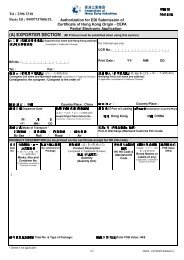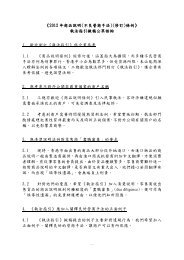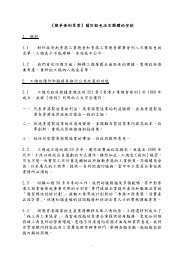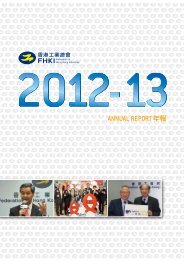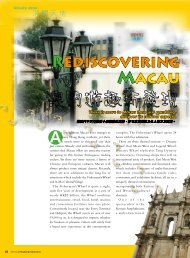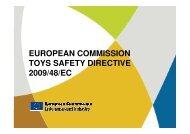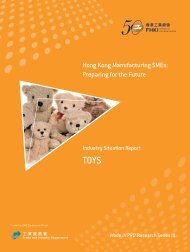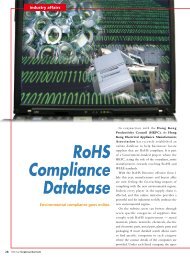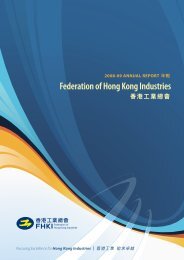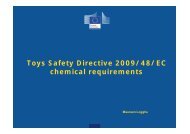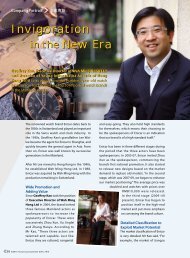Hong Kong Manufacturing SMEs: Preparing for the Future
Hong Kong Manufacturing SMEs: Preparing for the Future
Hong Kong Manufacturing SMEs: Preparing for the Future
- No tags were found...
You also want an ePaper? Increase the reach of your titles
YUMPU automatically turns print PDFs into web optimized ePapers that Google loves.
88Issues <strong>for</strong> <strong>Hong</strong> <strong>Kong</strong> Toy ManufacturersSimilar to o<strong>the</strong>r <strong>Hong</strong> <strong>Kong</strong> manufacturers in <strong>the</strong>PRD, <strong>Hong</strong> <strong>Kong</strong> toy companies also face challengesfrom changes in markets, powerful buyers andlicense holders, increasing competition, andincreased costs associated with rising wage ratesand input costs, <strong>the</strong> appreciation of <strong>the</strong> RMB, <strong>the</strong>implementation of <strong>the</strong> Labour Contract Law, andshifts in policies on export processing. In addition,as a relatively labour-intensive and low value-addedindustry, <strong>the</strong> toy sector is feeling <strong>the</strong> effects of <strong>the</strong>industrial upgrading movement that is being pushedby both <strong>the</strong> Central and Guangdong ProvincialGovernments. As an industry heavily reliant onboth plastics and packaging, it also attracts itsshare of attention from Mainland and overseasenvironmentalists concerned about production oflarge amounts of yet more potential waste, despiteindustry ef<strong>for</strong>ts to use recycled plastic materials.The toy sector was under pressure be<strong>for</strong>e <strong>the</strong>onset of <strong>the</strong> global economic downturn in 2008.Wage increases in <strong>the</strong> toy sector had been risingat double digit per centages each year. In addition,it is estimated that <strong>the</strong> implementation of LabourContract Law alone added 30 per cent to <strong>the</strong> labourcosts <strong>for</strong> toy manufacturers in <strong>the</strong> PRD. 164 The priceof raw materials used in toy manufacturing, such asplastic and metal fittings, had also increased. 165 Thetoy sector was also negatively impacted by changesmade by Mainland Government authorities in June2007 that lowered <strong>the</strong> export VAT rebate <strong>for</strong> toys164 www.fisme.hk165 Wei Jin, “Winter of Toy Industry in China”, Consumer Guide –Academic version, April 2010.166 Note that <strong>the</strong> <strong>Hong</strong> <strong>Kong</strong> Toys Council estimates that in 2007<strong>the</strong>re were 8,500 toy factories and exporters in Guangdongand that this had decreased to about 3,000 toy factories andexporters by 2010.167 Wei Jin, “Winter of Toy Industry in China,” Consumer Guide –Academic version, April 2010.168 www.easttoys.com.169 www.glokids.cn.170 www.past5000.com.171 See <strong>Hong</strong> <strong>Kong</strong> Trade Development Council, “<strong>Hong</strong> <strong>Kong</strong>’sExport Outlook <strong>for</strong> 2010: Challenges amid a Slow GlobalRecovery,” 16 December 2009.from 13 per cent to 11 per cent. In 2007, 1,454of <strong>the</strong> 1,725 toy factories inspected in Guangdongwere found to have safety flaws. A total of 764 of<strong>the</strong>se factories lost <strong>the</strong>ir export licences or had <strong>the</strong>msuspended. In August 2007, <strong>the</strong> Certification andAccreditation Administration of China issued newregulations <strong>for</strong> toy exporters that makes it moredifficult to obtain and retain an export licence.According to Guangdong Customs, from Januaryto July in 2008 <strong>the</strong>re were 1,404 toy companiesin Guangdong doing export business, which was3,618 fewer than one year earlier 166 . This meansthat 72 per cent of <strong>the</strong> toy companies ei<strong>the</strong>r exited<strong>the</strong> export market altoge<strong>the</strong>r or put <strong>the</strong>ir exportingactivities on hold. 167In <strong>the</strong> first quarter of 2009, <strong>the</strong> EU announced 143 toyrecalls, 134 of which concerned toys that originatedfrom <strong>the</strong> Chinese Mainland. During <strong>the</strong> same period,<strong>the</strong> US and Canada announced 13 toy recalls, all ofwhich were <strong>for</strong> Chinese products. This led to ano<strong>the</strong>rround of new safety and environmental laws in<strong>the</strong> US and EU. The combination of new Chineseand overseas regulations have increased input,compliance, quality management, and licence costs.Demand <strong>for</strong> toys from <strong>the</strong> US and <strong>the</strong> EU decreaseddramatically with <strong>the</strong> onset of <strong>the</strong> global economicdownturn. In 2009 and <strong>Hong</strong> <strong>Kong</strong>’s exports to <strong>the</strong>setwo markets were down 19 per cent from 2008. Inresponse, <strong>the</strong> Chinese Government raised <strong>the</strong> exporttax rebate <strong>for</strong> toy exports from 11 per cent to 14 percent in November 2008, and fur<strong>the</strong>r raised <strong>the</strong> exporttax rebate to 15 per cent in June 2009, in an attemptto stimulate toy exports. In <strong>the</strong> first ten months of2009, toy exports in China decreased 11.2 per cent,and toy exports in Guangdong Province decreased10.9 per cent. 168 Industrial players estimated that <strong>Hong</strong><strong>Kong</strong>’s toy exports would grow between zero and 10per cent in 2010. 169 In <strong>the</strong> first four months of 2010,Guangdong’s toy exports increased 21.4 per cent yearon-year.However, Guangdong Customs indicatedthat most of <strong>the</strong> orders were short-term orders, and<strong>the</strong> outlook of <strong>the</strong> industry was still uncertain. 170 Asurvey published by HKTDC in December 2009 171indicated that <strong>the</strong> demand <strong>for</strong> basic toys will continue



